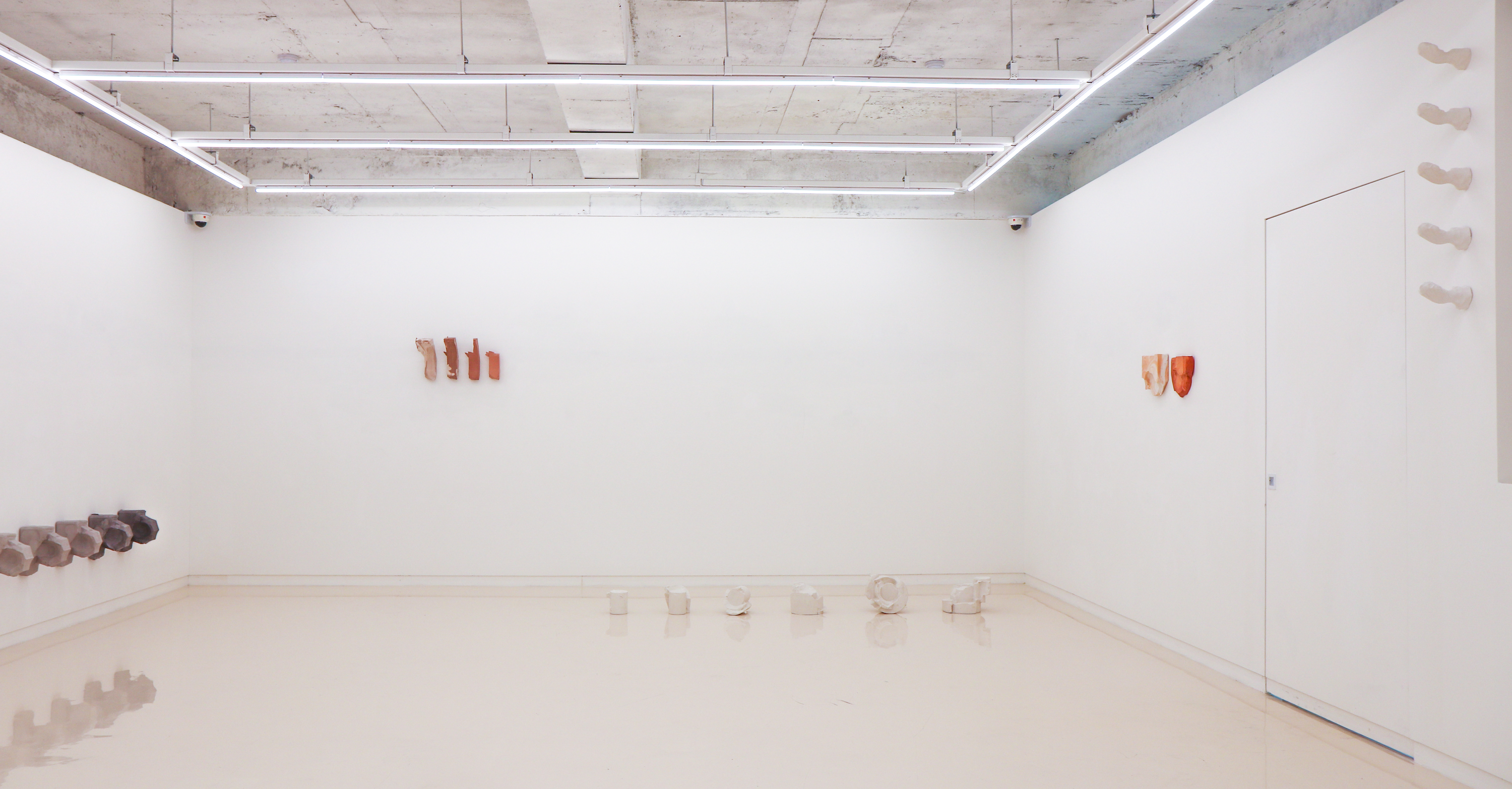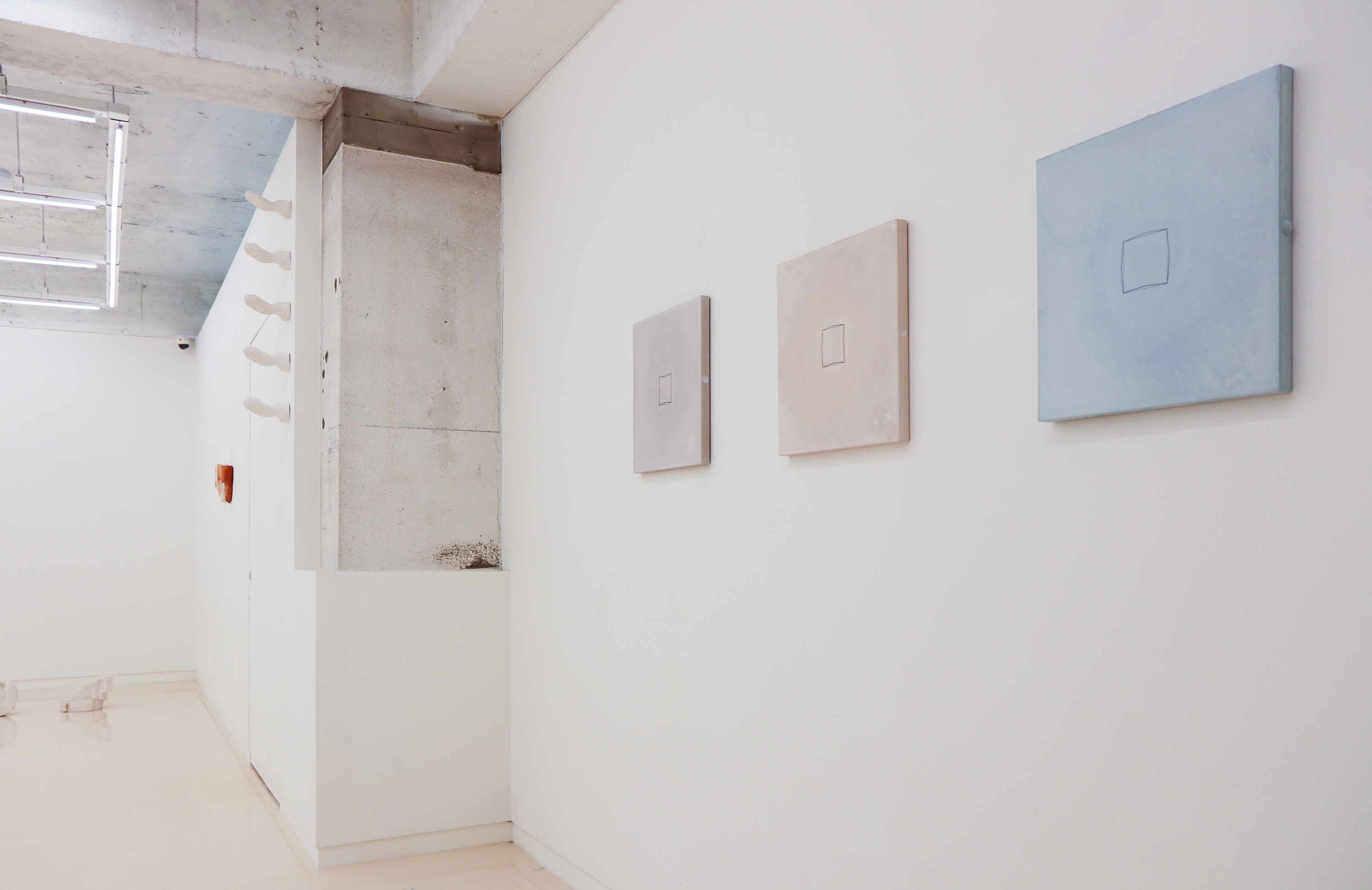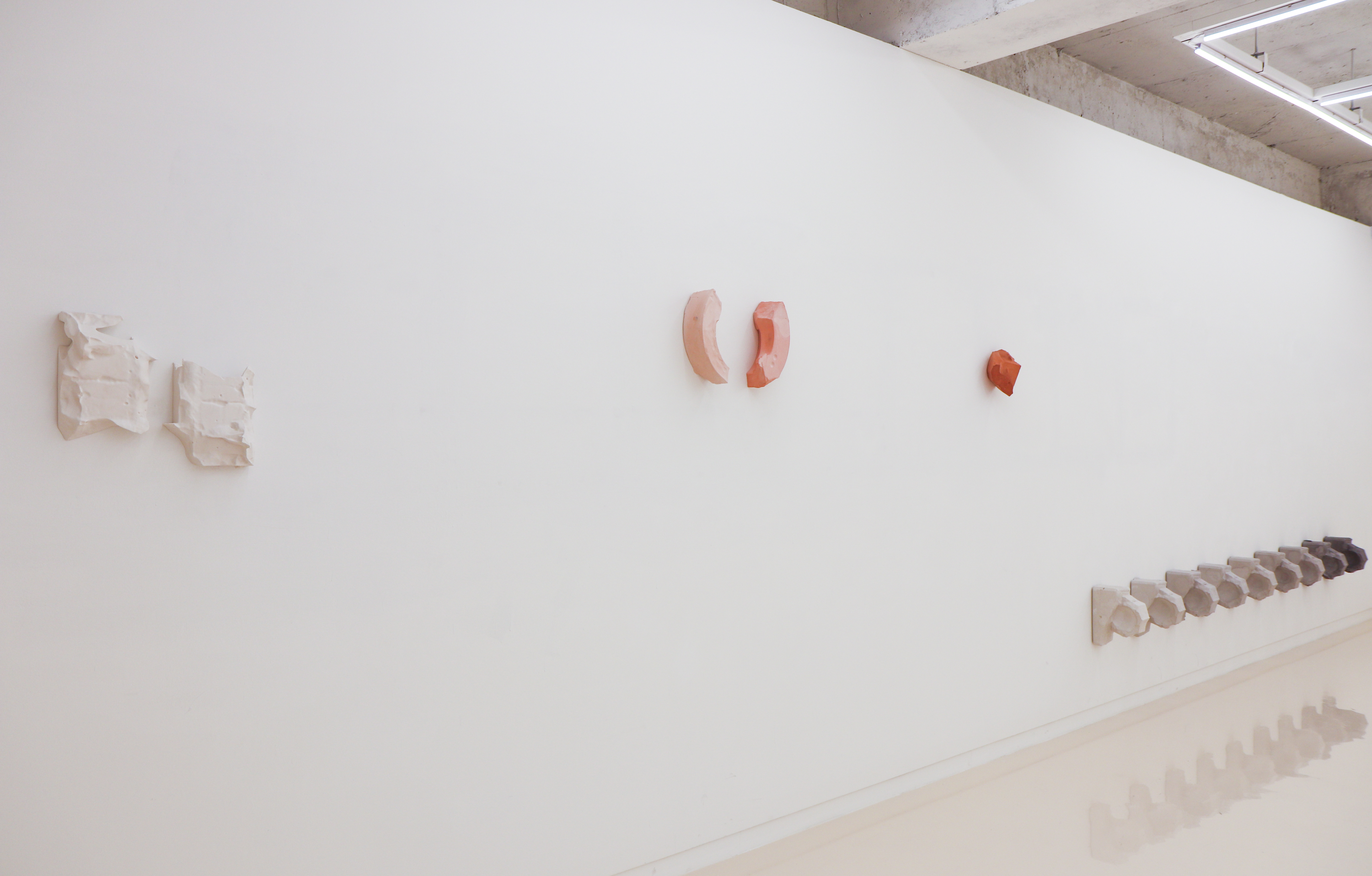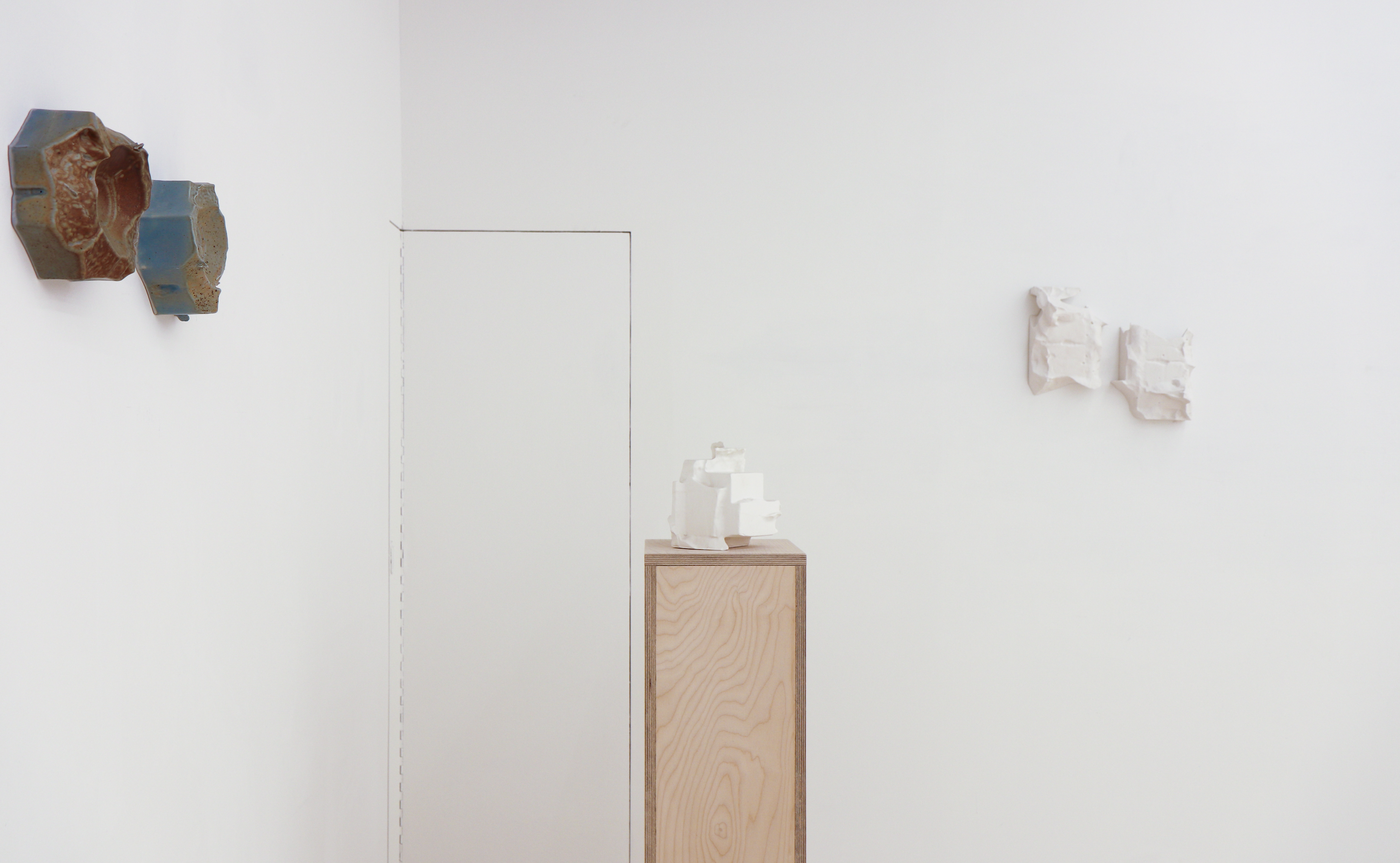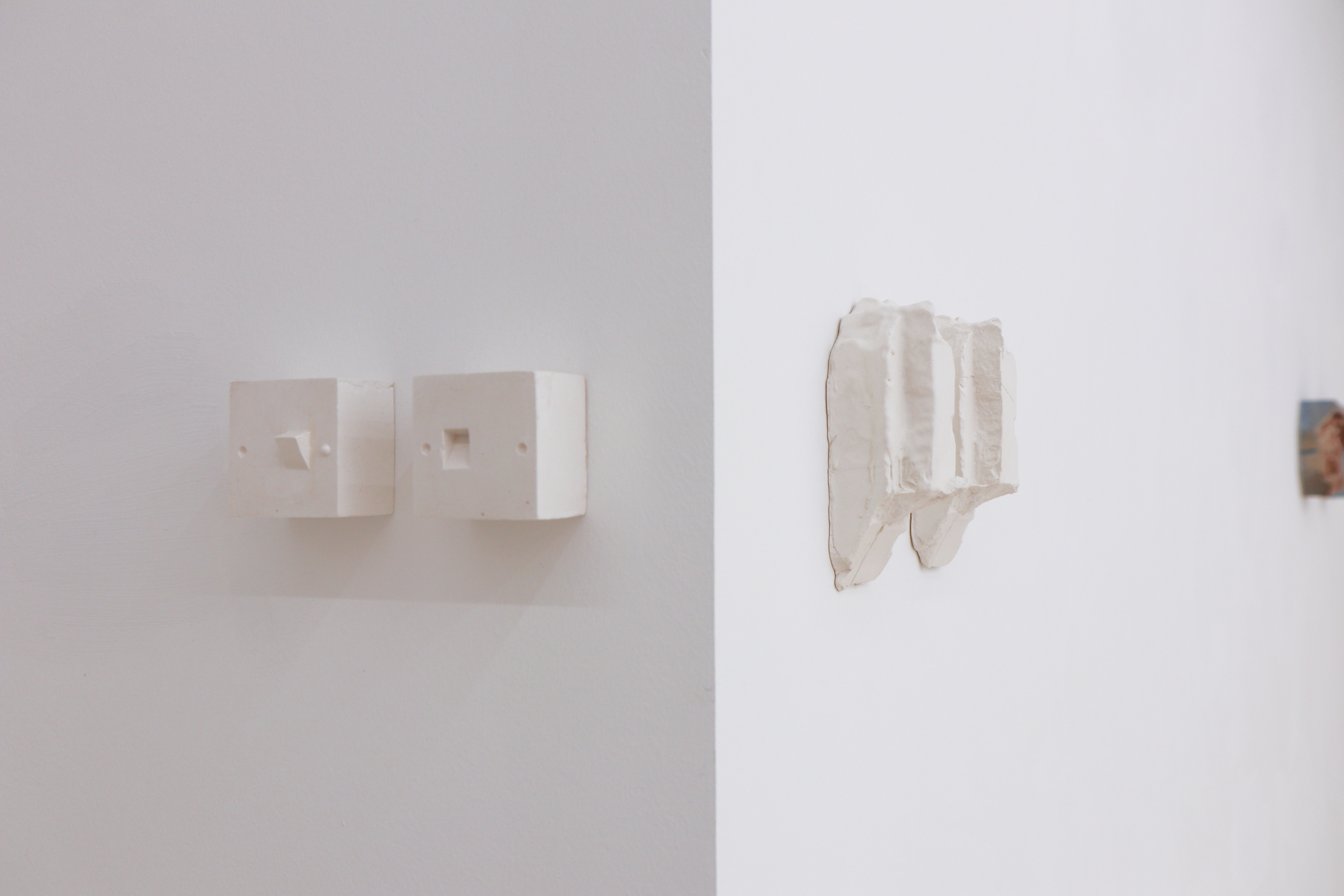chocolate milk cow milk
Solo exhibition
February 7 - March 25, 2023
Thomas Park
Itaewon-ro 199, 4F, Seoul, South Korea
토마스파크: 서울시 용산구 이태원로 199, 4층
Photos by Obofob (오브오브오브)


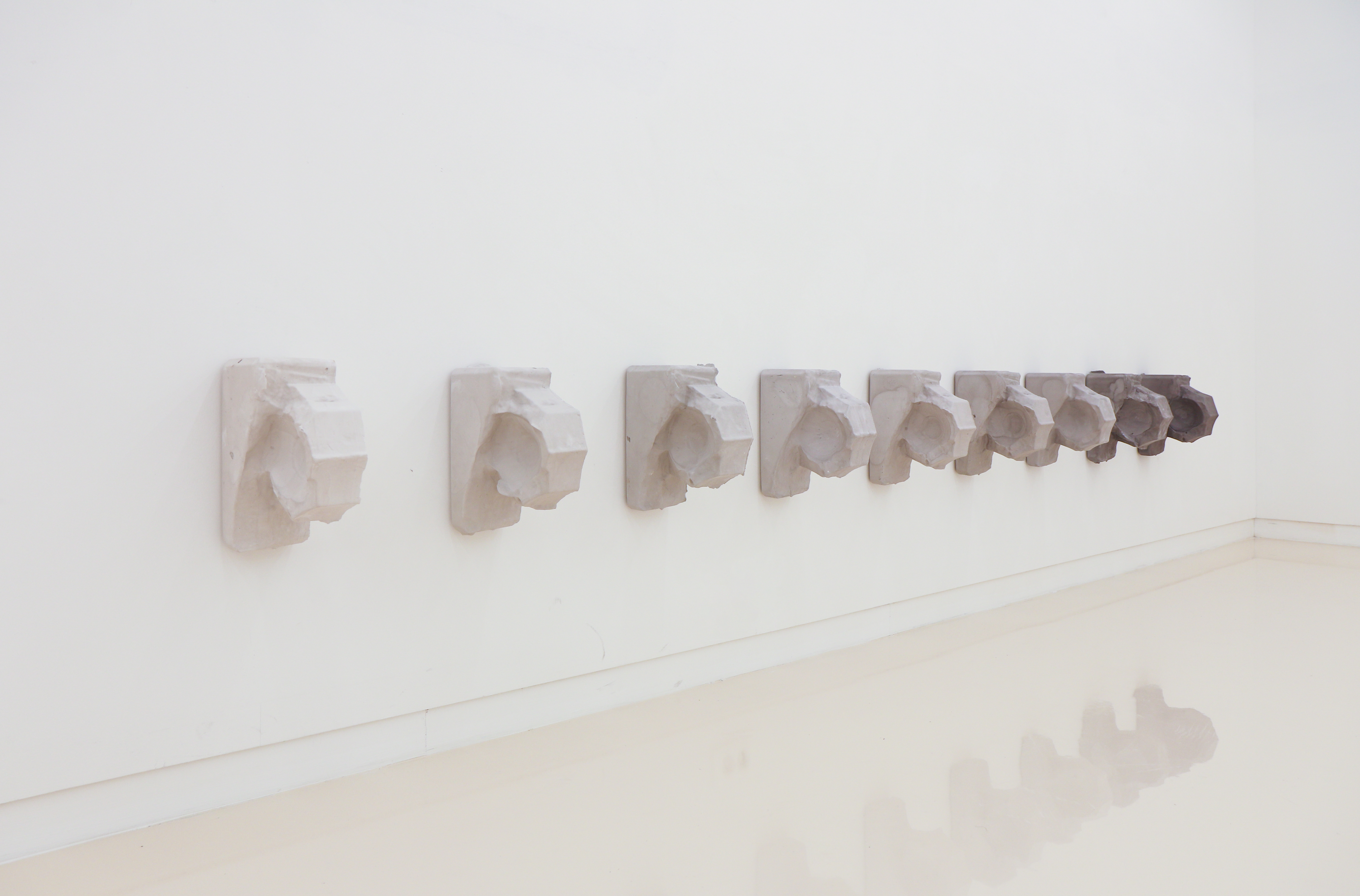
Unaccustomed Earth could have been the title of Hae Won Sohn's solo show, the first one in her native country. (It is the title of the book I translated years ago, which Jhumpa Lahiri, an Indian-American writer, wrote.) Since Nathaniel Hawthorne uttered his famous prophecy in 1850, "Human nature will not flourish, any more than a potato, if it be planted and replanted… in the same worn-out soil. My children have had other birthplaces and… shall strike their roots into unaccustomed earth." human nature indeed flourished. Hae Won Sohn was born in Korea in 1992, and moved to Davis, CA, when she was four years old, where her father was doing his Ph.D. at UC Davis. After four years, in 2000, her family moved back to Korea, where Sohn spent most of her adolescent years. Sohn studied ceramic crafts at Kookmin University in Korea before she pursued her graduate studies at the Cranbrook Academy of Arts, MI, in 2016. Since finishing her program in a small city outside Detroit, she has had more than five studios in Long Island City, NY, Baltimore, MD, and Brooklyn, NY, constantly going back and forth between places. Now she feels more settled in NY, living in Queens and working in Brooklyn. Undoubtedly, Sohn is one of many children of Hawthorne.
To anyone who experienced a relocation that required moving from one culture to another, they would feel the impact of the phrase "shall strike their roots into unaccustomed earth," the physical hardness of the "earth" and the sheer amount of force it takes to "strike their roots." Considering her peripatetic life, it is all the more poignant to think about aspects of Sohn's practice. She studied ceramics in the field of "Crafts," not in the fine arts, if there is any distinction, dealing with clay, with all the physical labor and technicality that goes into it. While she was studying and learning, her mind was already bridging fields of practice and merging different histories of skill sets. The program at Kookmin University focused on the traditional approach to ceramic making in Korea. Interestingly enough, with her mind already taking off from the traditional approach, she transplanted her roots to American soil and enrolled in the ceramics department at Cranbrook, where the tradition of making ceramics is also practiced and celebrated. In this program, she decided to explore an industrial technique called "slip-casting," used to make porcelain amenities like toilets. While in the industry, they would repeat the process to produce the same model in large numbers; she utilized this method to create "unique multiples."
In traditional sculpture practice, sculptors make multiples as well. They build a form and mold to produce the same work repeatedly. Here, their goal is to get the form. Watching how the process of making multiples go, Sohn decides to try it differently. Her "standard" process can be like this; she would make an object, make the mold, then break the mold, attach the broken piece of mold to an object, make a new mold from that combined object, and repeat the process. For her, making mold is not to contain the form; it is to break out of a form. Sohn says that her sculptures "develop their structural genesis based on a repetitive process of making molds, breaking molds, casting molds, breaking the molds of molds, casting the molds of molds, and so on. The concept of casting and mold-making become homogeneous as the mold becomes the cast and vice versa. Fragments of the cast form migrate to the mold, making the positive and negative dichotomy indistinguishable.”
Auguste Rodin is a sculptor who paid unprecedented attention to using fragments of sculpture. While working on a massive project The Gates of Hell, he amassed many complete figures and their fragments. Even before this project, he experimented with partial figures and body parts as he did with The Torso of Walking Man and showed only the body parts of a figure he called abattis. Rodin dismantled and reassembled the pieces from different origins in an unexpected way. The well-known examples are Female Torso with the Hand of a Skeleton on her Belly (c 1890), The Mask of Camille Claudel with the hand of Pierre de Wissant (c 1895), and Torso of the Woman Centaur and Minotaur (c. 1910) among many. Upon writing Rodin's monograph, Rainer Maria Rilke observed that "Never was human body assembled to such an extent about its inner self, so bent by its own soul…." Parts of the human body naturally evoke a sense of an "inner" state; it reveals the abstract aspect of the human form and existence and makes us think about the making of it.
A sculpture is something we see; we don't get to see the process of making one. Sohn went directly into the realm of the invisible, taking the entire process of making sculpture as her subject matter and manipulating it as if it were clay. The resulting form itself is less of an issue for her. It is more important how she deals with the dichotomy between visible and invisible, inside and outside, negative and positive, intended and accidental, and so on. Her "space" as an artist is in-between. Even though she majored in ceramic crafts in Korea, her work barely shows her background. But the business of dealing with the unexpected, the accidental—often disastrous— aspect of making Korean ceramics, is embedded in her work. She takes that aspect of the process and turns it into something productive.
She would make a form like a cylinder for an original form to cast. I think of Cezanne when I think of a cylinder; however, Sohn's concept of a cylinder comes from a factory's production line, for a cylinder is one of the most often used forms of mold in factories. Square Dreams (2020) is a "procession" of six pieces that are "borne" of and break out of a cylinder. It is a procession of six "stages" of a cylinder transforming into more complex forms with the addition of fragments of mold. It is funny she titled it Square Dreams because there is no square in sight. Is a cylinder a square's dream? Sohn advises that Square Dreams is a work that evolved from her previous work, Hiatus(2018), which was a procession of a cube progressing to complex forms. Self-referencing, repeating forms she already made, is part of her methodology of creating “unique multiples.”
In chocolate milk cow milk (2022), it is vague if it is a progression or a repetition. Four arc-like forms are attached to the wall varying in size and color. All objects look like broken pieces; one on the far right seems broken in half. These are fragments of molds of the mold of (chrysanthemum) (2022), which came out of the mold of Square Dreams. In (chrysanthemum), the arc-like objects look like parenthesis, whereas in chocolate milk, they look like the bows or ribs of cows. She gives the work titles loosely inspired by associations, wordplay, and innate metaphors and there is always enough space given between the work and the title. In chocolate milk cow milk, each object may correspond with each word in the title, she suggests. Or the whole thing might be an allegory of how the artificial (e.g., art) intertwines with nature(e.g., material), the form with language.
I am not sure if Hae Won Sohn will ever “strike her root” into unaccustomed earth. But she lives on and with "unaccustomed earth," exploring unknown territory like a child playing in a new playground. She seems to do everything with such ease, playfulness, and yet everything works on a metaphorical level. In Lion Heart(2022), a cube's corner protrudes through what looks like rubbles. Does it look like a civilization peeking through rocks? It might even appear when her work reveals its form in the material and process. With all its metaphorical power, it does have a shape of a heart. Yes, it may take a heart of a lion to roam about unaccustomed earth.
To anyone who experienced a relocation that required moving from one culture to another, they would feel the impact of the phrase "shall strike their roots into unaccustomed earth," the physical hardness of the "earth" and the sheer amount of force it takes to "strike their roots." Considering her peripatetic life, it is all the more poignant to think about aspects of Sohn's practice. She studied ceramics in the field of "Crafts," not in the fine arts, if there is any distinction, dealing with clay, with all the physical labor and technicality that goes into it. While she was studying and learning, her mind was already bridging fields of practice and merging different histories of skill sets. The program at Kookmin University focused on the traditional approach to ceramic making in Korea. Interestingly enough, with her mind already taking off from the traditional approach, she transplanted her roots to American soil and enrolled in the ceramics department at Cranbrook, where the tradition of making ceramics is also practiced and celebrated. In this program, she decided to explore an industrial technique called "slip-casting," used to make porcelain amenities like toilets. While in the industry, they would repeat the process to produce the same model in large numbers; she utilized this method to create "unique multiples."
In traditional sculpture practice, sculptors make multiples as well. They build a form and mold to produce the same work repeatedly. Here, their goal is to get the form. Watching how the process of making multiples go, Sohn decides to try it differently. Her "standard" process can be like this; she would make an object, make the mold, then break the mold, attach the broken piece of mold to an object, make a new mold from that combined object, and repeat the process. For her, making mold is not to contain the form; it is to break out of a form. Sohn says that her sculptures "develop their structural genesis based on a repetitive process of making molds, breaking molds, casting molds, breaking the molds of molds, casting the molds of molds, and so on. The concept of casting and mold-making become homogeneous as the mold becomes the cast and vice versa. Fragments of the cast form migrate to the mold, making the positive and negative dichotomy indistinguishable.”
Auguste Rodin is a sculptor who paid unprecedented attention to using fragments of sculpture. While working on a massive project The Gates of Hell, he amassed many complete figures and their fragments. Even before this project, he experimented with partial figures and body parts as he did with The Torso of Walking Man and showed only the body parts of a figure he called abattis. Rodin dismantled and reassembled the pieces from different origins in an unexpected way. The well-known examples are Female Torso with the Hand of a Skeleton on her Belly (c 1890), The Mask of Camille Claudel with the hand of Pierre de Wissant (c 1895), and Torso of the Woman Centaur and Minotaur (c. 1910) among many. Upon writing Rodin's monograph, Rainer Maria Rilke observed that "Never was human body assembled to such an extent about its inner self, so bent by its own soul…." Parts of the human body naturally evoke a sense of an "inner" state; it reveals the abstract aspect of the human form and existence and makes us think about the making of it.
A sculpture is something we see; we don't get to see the process of making one. Sohn went directly into the realm of the invisible, taking the entire process of making sculpture as her subject matter and manipulating it as if it were clay. The resulting form itself is less of an issue for her. It is more important how she deals with the dichotomy between visible and invisible, inside and outside, negative and positive, intended and accidental, and so on. Her "space" as an artist is in-between. Even though she majored in ceramic crafts in Korea, her work barely shows her background. But the business of dealing with the unexpected, the accidental—often disastrous— aspect of making Korean ceramics, is embedded in her work. She takes that aspect of the process and turns it into something productive.
She would make a form like a cylinder for an original form to cast. I think of Cezanne when I think of a cylinder; however, Sohn's concept of a cylinder comes from a factory's production line, for a cylinder is one of the most often used forms of mold in factories. Square Dreams (2020) is a "procession" of six pieces that are "borne" of and break out of a cylinder. It is a procession of six "stages" of a cylinder transforming into more complex forms with the addition of fragments of mold. It is funny she titled it Square Dreams because there is no square in sight. Is a cylinder a square's dream? Sohn advises that Square Dreams is a work that evolved from her previous work, Hiatus(2018), which was a procession of a cube progressing to complex forms. Self-referencing, repeating forms she already made, is part of her methodology of creating “unique multiples.”
In chocolate milk cow milk (2022), it is vague if it is a progression or a repetition. Four arc-like forms are attached to the wall varying in size and color. All objects look like broken pieces; one on the far right seems broken in half. These are fragments of molds of the mold of (chrysanthemum) (2022), which came out of the mold of Square Dreams. In (chrysanthemum), the arc-like objects look like parenthesis, whereas in chocolate milk, they look like the bows or ribs of cows. She gives the work titles loosely inspired by associations, wordplay, and innate metaphors and there is always enough space given between the work and the title. In chocolate milk cow milk, each object may correspond with each word in the title, she suggests. Or the whole thing might be an allegory of how the artificial (e.g., art) intertwines with nature(e.g., material), the form with language.
I am not sure if Hae Won Sohn will ever “strike her root” into unaccustomed earth. But she lives on and with "unaccustomed earth," exploring unknown territory like a child playing in a new playground. She seems to do everything with such ease, playfulness, and yet everything works on a metaphorical level. In Lion Heart(2022), a cube's corner protrudes through what looks like rubbles. Does it look like a civilization peeking through rocks? It might even appear when her work reveals its form in the material and process. With all its metaphorical power, it does have a shape of a heart. Yes, it may take a heart of a lion to roam about unaccustomed earth.
Mimi Park
손해원의 개인전, 모국에서 열리는 그녀의 첫 전시 제목으로 나는 <길들지 않은 땅>을 떠올렸었다. (이는 내가 몇 년 전 번역한, 인도계 미국인 작가인 줌파 라히리Jhumpa Lahiri가 쓴 책의 제목이기도 하다.) 나다니엘 호손Nathaniel Hawthorne이 1850년에 한 유명한 예언, "인류의 인간성은, 마치 감자처럼 같은 땅에 심고 또 심으면… 번성하지 못할 것이다. 내 아이들은 출생지가 달랐으니…. 길들지 않은 땅에 뿌리를 내리리라." 이후로, 인류는 그야말로 번성해왔다. 1992년 한국에서 태어난 손해원은 4살 때, 아버지가 박사 과정을 밟고 있던 UC 데이비스가 있는 캘리포니아주 데이비스로 이사했다. 4년 후인 2000년, 그녀의 가족은 한국으로 돌아왔고, 손해원은 대부분의 청소년기를 한국에서 보냈다. 손해원은 국민대학교에서 도예를 전공한 후, 2016년에 미시간주 크랜브룩 예술대학의 대학원에 진학했다. 디트로이트 외곽의 작은 도시에서 대학원을 마친 후 그녀는 뉴욕 롱아일랜드 시티, 메릴랜드 주 볼티모어, 브룩클린 등으로 여러 번 거주지를 옮기며, 5개 이상의 작업실에서 작업해왔다. 이제 그녀는 퀸즈에서 살고 브룩클린에서 작업하며, 뉴욕에 정착한 듯 보인다. 손해원은 호손이 예견한 많은 “아이들” 중 한 명임에 틀림없다.
한 문화에서 다른 문화의 이주를 경험한 사람이라면 "길들지 않은 땅에 뿌리를 내리리라”라는 문구를 접했을때, 그 “땅”이라는 게 얼마나 단단한지, 그 땅에 뿌리 내릴 때 쏟아야 하는 힘과 고통이 몸으로 느껴질 것이다. 이주가 잦았던 손해원의 삶을 생각하면, 그녀 작업의 성격과 그 의미가 더욱 신기하게 느껴진다. 그녀는 미대가 아닌 도자공예학과에서 흙을 만지며, 도예작업에 필요한 육체노동과 전문적인 기술들을 익혔다. 여기서 공부하고 배우는 동안에 그녀는 이미 분야를 넘나들고 서로 다른 기술을 어떻게 합치나 궁리하기 시작했다. 국민대학교의 도자공예학과는 한국의 도자 전통에 기반을 한 학과였고, 그곳에서 여러 실험적인 생각을 하던 그녀는 뿌리를 미국으로 옮겨 미시간주 크랜브룩 대학의 석사 과정에 진학하기로 결심한다. 이는 흥미로운 선택이었는데, 크랜브룩 또한 전통적 도예를 중시하고 이와 관련한 전문 기술들을 가르치는 곳이기 때문이다. 이 프로그램에서 그녀는 변기와 같은 세라믹 설비 등을 만드는 데 사용되는 기술인 "슬립 캐스팅"에 관심을 갖는다. 실제 업계에서 이 기술은 같은 모델을 대량으로 제작하기 위해 사용되는데, 손해원은 이 기술을 “유일한 에디션”를 만들기 위해 사용한다.
전통적인 조각 분야에서도 조각가들은 에디션을 만든다. 그들은 원형과 동일한 형태를 반복적으로 만들기 위해 몰드를 제작한다. 여기서 그들의 목표는 형태이다. 손해원은 동일한 형태를 생산하는 과정을 지켜보며 자기 만의 방식을 시도한다. 그녀의 작업과정은 종종 다음과 같은 과정을 포함한다. 형태를 만들고, 몰드를 만들고, 몰드를 깨고, 깨진 몰드의 부분을 원형에 붙이고, 그 새로운 조합의 몰드를 만들고.. 그리고 그 과정을 반복한다. 그녀에게 있어 몰드는 형태를 담아내기 위한 것이 아니라 형태에서 벗어나기 위한 것이다. 손해원은 자신의 작업에 대해 이렇게 말한다. “내 조각의 구조적 기원은 몰드를 만들고, 몰드를 깨고, 몰드를 캐스팅하고, 몰드의 몰드를 깨고, 몰드의 몰드를 다시 캐스팅하는, 반복적인 과정 속에 존재한다. 몰드 자체가 캐스팅되고 그 역이 또 가능해지며 캐스팅과 몰드 제작의 개념이 동질화된다. 캐스팅된 형태의 파편이 다시 몰드로 옮겨지며, 양각과 음각의 구분조차 사라지게 된다.”
오귀스트 로댕은 조각의 파편을 다시 이용하는데 전례없는 관심을 기울인 조각가이다. <지옥의 문>이라는 대작을 위해 작업하는 동안 그는 완성된 조각상과 그 파편들을 다수 모으게 되었다. 이 프로젝트 이전에도 <걸어가는 남자의 토르소>처럼 잘라진 신체상과 신체 부위를 가지고 실험적인 작업을 했는데, 그가 “아바티스”라고 부른 신체 부위 조각들만으로 전시를 하기도 했다. 로댕은 서로 기원이 다른, 잘라진 조각들을 취하여 예상치못한 방식으로 재조립했다. 잘 알려진 예로, <배에 해골의 손을 얹은 여성의 토르소>(c 1890), <피에르 드 위상의 손과 까미유 끌로델의 마스크>(c 1895), <여성 센토르와 미노타우르스의 토르소>(c. 1910)이 있다. 로댕의 도록에 들어가는 글에서 라이너 마리아 릴케는 “영혼이 이런 곡선을 그리는 것인지…. 인간의 내면이 이 정도로 표현되도록 인체가 조합된 적이 없었다."라고 했다. 잘라진 인체 형상의 일부는 자연스럽게 어떤 "내적" 상태를 연상시키며, 인체의 추상성, 인간의 실존적 측면을 드러내고, 그리고 인체 형상을 만드는 과정에 대해 생각하게 한다.
조각은 눈에 보이지만 이를 만드는 과정은 눈에 보이지 않는다. 손해원은 이 보이지 않는 세계로 곧장 들어가 조각 제작 과정 자체를 소재로 삼아 마치 흙을 만지듯 주물럭거린다. 그녀에겐 결과로 나오는 형태 자체보다, 보이는 것과 보이지 않는 것, 안과 밖, 양각과 음각, 의도와 우연 등의 이분법을 어떻게 다루느냐가 더 중요하다. 예술가로서의 그녀의 '공간'은 이들 사이에 존재한다. 그녀의 작품에 한국에서 도예를 전공한 배경의 흔적을 찾아보기는 쉽지 않을 수도 있다. 하지만 한국 도자 제작의 우연적인, 예상치 못한 (종종 도자기는 가마 속에서 갈라지거나 주저앉는다) 측면을 다루는 일이 그녀의 작업 속에 내재되어 있다. 그녀는 제작 과정의 이러한 측면을 역으로 이용하여 실패가 만들어내는 형태에 주목한다.
예를 들어 그녀는 원기둥으로 원형을 만들고 캐스팅한다. 나는 원기둥을 떠올리면 세잔이 생각나는데, 손해원의 원기둥은 공장의 생산 라인에서 온 것이다. 원기둥 형태는 공장에서 가장 많이 사용되는 몰드의 형태이기 때문이다. <정사각 꿈 Square Dreams>(2020)는 원기둥에서 비롯되어 원기둥을 벗어나는 여섯 가지 형태의 배열이다. 몰드의 파편이 원기둥에 붙어 변형을 거듭하여 복잡한 형태가 되어가는 여섯 “단계”를 배열한 것이다. 이 작품의 제목이 <정사각 꿈>이라는 것은 재미있다. 정사각형은 어디에도 보이지 않기 때문이다. 원기둥은 정사각형의 꿈일까? 손해원은 실제로 <정사각 꿈>은 정육면체가 복잡한 형태로 진행되는, 그녀의 이전 작업 <잠시 중단Hiatus 2018>에서 온 것이라고 한다. 자기 자신의 작업을 레퍼런스로 삼아 이전 작업의 형태를 반복하는 것은 그녀가 말한 “유일한 에디션”을 만들기 위한 방법론 중 하나다.
<초코 우유 젖소 우유>(2022)에선 작품들이 어떤 방향으로 진행되고 있는 것인지 한 형태가 반복되는 것인지 모호하다. 크기와 색상이 다른 4개의 호의 형태가 벽에 부착되어 있다. 여기서 모든 오브제는 부서진 것처럼 보이는데, 맨 오른쪽에 형태는 반토막난 것 같다. 이 형태들은 <정사각 꿈>의 몰드에서 나온 <(국화)>(2022)의 몰드를 캐스팅한 몰드에서 나온 것이다. <(국화)>에서 호 모양의 오브제는 괄호처럼 보이지만, <초코 우유>에서는 활이나 소의 갈비뼈처럼 보인다. 작가는 연상, 말장난, 내재된 은유에서 느슨한 방식으로 영감을 받아 제목을 정하는데, 작품과 제목 사이에는 항상 충분한 공간이 있다. <초코 우유 젖소 우유>에서 각 오브제는 제목의 각 단어와 상응하는 것일지도 모른다고, 그녀는 귀띔한다. 또는 제목을 포함한 전체 작품은 인공(예: 예술)이 자연(예: 재료)과, 형태가 언어와 어떻게 얽혀 있는지에 대한 은유로도 보인다.
손해원이 길들지 않은 땅에 결국 “뿌리를 내릴” 것인지는 확실하지 않다. 하지만 확실한 것은 그녀는 새로운 놀이터에서 노는 어린아이처럼 미지의 영역을 탐험하며 “길들지 않은 땅” 위에서, 함께 살고 있다. 그녀는 작업을 자연스럽게, 재미나게 하는 것처럼 보이지만 모든 것이 은유적인 수준에서 의미가 통한다. <사자 심장Lion Heart>(2022)에서는 육면체의 모서리가 돌무더기처럼 보이는 것들 위로 머리를 내밀고 있다. 암석을 뚫고 그 모습을 드러내는 문명의 흔적 같지 않은가? 재료 속에서, 과정 속에서 그녀의 작업이 형태를 드러내는 순간 같기도 하다. 작품은 전체적으로 심장의 모양을 연상시킨다. 길들지 않은 땅을 종횡무진 다니려면 사자의 심장쯤이 필요할지도 모르겠다.
한 문화에서 다른 문화의 이주를 경험한 사람이라면 "길들지 않은 땅에 뿌리를 내리리라”라는 문구를 접했을때, 그 “땅”이라는 게 얼마나 단단한지, 그 땅에 뿌리 내릴 때 쏟아야 하는 힘과 고통이 몸으로 느껴질 것이다. 이주가 잦았던 손해원의 삶을 생각하면, 그녀 작업의 성격과 그 의미가 더욱 신기하게 느껴진다. 그녀는 미대가 아닌 도자공예학과에서 흙을 만지며, 도예작업에 필요한 육체노동과 전문적인 기술들을 익혔다. 여기서 공부하고 배우는 동안에 그녀는 이미 분야를 넘나들고 서로 다른 기술을 어떻게 합치나 궁리하기 시작했다. 국민대학교의 도자공예학과는 한국의 도자 전통에 기반을 한 학과였고, 그곳에서 여러 실험적인 생각을 하던 그녀는 뿌리를 미국으로 옮겨 미시간주 크랜브룩 대학의 석사 과정에 진학하기로 결심한다. 이는 흥미로운 선택이었는데, 크랜브룩 또한 전통적 도예를 중시하고 이와 관련한 전문 기술들을 가르치는 곳이기 때문이다. 이 프로그램에서 그녀는 변기와 같은 세라믹 설비 등을 만드는 데 사용되는 기술인 "슬립 캐스팅"에 관심을 갖는다. 실제 업계에서 이 기술은 같은 모델을 대량으로 제작하기 위해 사용되는데, 손해원은 이 기술을 “유일한 에디션”를 만들기 위해 사용한다.
전통적인 조각 분야에서도 조각가들은 에디션을 만든다. 그들은 원형과 동일한 형태를 반복적으로 만들기 위해 몰드를 제작한다. 여기서 그들의 목표는 형태이다. 손해원은 동일한 형태를 생산하는 과정을 지켜보며 자기 만의 방식을 시도한다. 그녀의 작업과정은 종종 다음과 같은 과정을 포함한다. 형태를 만들고, 몰드를 만들고, 몰드를 깨고, 깨진 몰드의 부분을 원형에 붙이고, 그 새로운 조합의 몰드를 만들고.. 그리고 그 과정을 반복한다. 그녀에게 있어 몰드는 형태를 담아내기 위한 것이 아니라 형태에서 벗어나기 위한 것이다. 손해원은 자신의 작업에 대해 이렇게 말한다. “내 조각의 구조적 기원은 몰드를 만들고, 몰드를 깨고, 몰드를 캐스팅하고, 몰드의 몰드를 깨고, 몰드의 몰드를 다시 캐스팅하는, 반복적인 과정 속에 존재한다. 몰드 자체가 캐스팅되고 그 역이 또 가능해지며 캐스팅과 몰드 제작의 개념이 동질화된다. 캐스팅된 형태의 파편이 다시 몰드로 옮겨지며, 양각과 음각의 구분조차 사라지게 된다.”
오귀스트 로댕은 조각의 파편을 다시 이용하는데 전례없는 관심을 기울인 조각가이다. <지옥의 문>이라는 대작을 위해 작업하는 동안 그는 완성된 조각상과 그 파편들을 다수 모으게 되었다. 이 프로젝트 이전에도 <걸어가는 남자의 토르소>처럼 잘라진 신체상과 신체 부위를 가지고 실험적인 작업을 했는데, 그가 “아바티스”라고 부른 신체 부위 조각들만으로 전시를 하기도 했다. 로댕은 서로 기원이 다른, 잘라진 조각들을 취하여 예상치못한 방식으로 재조립했다. 잘 알려진 예로, <배에 해골의 손을 얹은 여성의 토르소>(c 1890), <피에르 드 위상의 손과 까미유 끌로델의 마스크>(c 1895), <여성 센토르와 미노타우르스의 토르소>(c. 1910)이 있다. 로댕의 도록에 들어가는 글에서 라이너 마리아 릴케는 “영혼이 이런 곡선을 그리는 것인지…. 인간의 내면이 이 정도로 표현되도록 인체가 조합된 적이 없었다."라고 했다. 잘라진 인체 형상의 일부는 자연스럽게 어떤 "내적" 상태를 연상시키며, 인체의 추상성, 인간의 실존적 측면을 드러내고, 그리고 인체 형상을 만드는 과정에 대해 생각하게 한다.
조각은 눈에 보이지만 이를 만드는 과정은 눈에 보이지 않는다. 손해원은 이 보이지 않는 세계로 곧장 들어가 조각 제작 과정 자체를 소재로 삼아 마치 흙을 만지듯 주물럭거린다. 그녀에겐 결과로 나오는 형태 자체보다, 보이는 것과 보이지 않는 것, 안과 밖, 양각과 음각, 의도와 우연 등의 이분법을 어떻게 다루느냐가 더 중요하다. 예술가로서의 그녀의 '공간'은 이들 사이에 존재한다. 그녀의 작품에 한국에서 도예를 전공한 배경의 흔적을 찾아보기는 쉽지 않을 수도 있다. 하지만 한국 도자 제작의 우연적인, 예상치 못한 (종종 도자기는 가마 속에서 갈라지거나 주저앉는다) 측면을 다루는 일이 그녀의 작업 속에 내재되어 있다. 그녀는 제작 과정의 이러한 측면을 역으로 이용하여 실패가 만들어내는 형태에 주목한다.
예를 들어 그녀는 원기둥으로 원형을 만들고 캐스팅한다. 나는 원기둥을 떠올리면 세잔이 생각나는데, 손해원의 원기둥은 공장의 생산 라인에서 온 것이다. 원기둥 형태는 공장에서 가장 많이 사용되는 몰드의 형태이기 때문이다. <정사각 꿈 Square Dreams>(2020)는 원기둥에서 비롯되어 원기둥을 벗어나는 여섯 가지 형태의 배열이다. 몰드의 파편이 원기둥에 붙어 변형을 거듭하여 복잡한 형태가 되어가는 여섯 “단계”를 배열한 것이다. 이 작품의 제목이 <정사각 꿈>이라는 것은 재미있다. 정사각형은 어디에도 보이지 않기 때문이다. 원기둥은 정사각형의 꿈일까? 손해원은 실제로 <정사각 꿈>은 정육면체가 복잡한 형태로 진행되는, 그녀의 이전 작업 <잠시 중단Hiatus 2018>에서 온 것이라고 한다. 자기 자신의 작업을 레퍼런스로 삼아 이전 작업의 형태를 반복하는 것은 그녀가 말한 “유일한 에디션”을 만들기 위한 방법론 중 하나다.
<초코 우유 젖소 우유>(2022)에선 작품들이 어떤 방향으로 진행되고 있는 것인지 한 형태가 반복되는 것인지 모호하다. 크기와 색상이 다른 4개의 호의 형태가 벽에 부착되어 있다. 여기서 모든 오브제는 부서진 것처럼 보이는데, 맨 오른쪽에 형태는 반토막난 것 같다. 이 형태들은 <정사각 꿈>의 몰드에서 나온 <(국화)>(2022)의 몰드를 캐스팅한 몰드에서 나온 것이다. <(국화)>에서 호 모양의 오브제는 괄호처럼 보이지만, <초코 우유>에서는 활이나 소의 갈비뼈처럼 보인다. 작가는 연상, 말장난, 내재된 은유에서 느슨한 방식으로 영감을 받아 제목을 정하는데, 작품과 제목 사이에는 항상 충분한 공간이 있다. <초코 우유 젖소 우유>에서 각 오브제는 제목의 각 단어와 상응하는 것일지도 모른다고, 그녀는 귀띔한다. 또는 제목을 포함한 전체 작품은 인공(예: 예술)이 자연(예: 재료)과, 형태가 언어와 어떻게 얽혀 있는지에 대한 은유로도 보인다.
손해원이 길들지 않은 땅에 결국 “뿌리를 내릴” 것인지는 확실하지 않다. 하지만 확실한 것은 그녀는 새로운 놀이터에서 노는 어린아이처럼 미지의 영역을 탐험하며 “길들지 않은 땅” 위에서, 함께 살고 있다. 그녀는 작업을 자연스럽게, 재미나게 하는 것처럼 보이지만 모든 것이 은유적인 수준에서 의미가 통한다. <사자 심장Lion Heart>(2022)에서는 육면체의 모서리가 돌무더기처럼 보이는 것들 위로 머리를 내밀고 있다. 암석을 뚫고 그 모습을 드러내는 문명의 흔적 같지 않은가? 재료 속에서, 과정 속에서 그녀의 작업이 형태를 드러내는 순간 같기도 하다. 작품은 전체적으로 심장의 모양을 연상시킨다. 길들지 않은 땅을 종횡무진 다니려면 사자의 심장쯤이 필요할지도 모르겠다.
박상미


